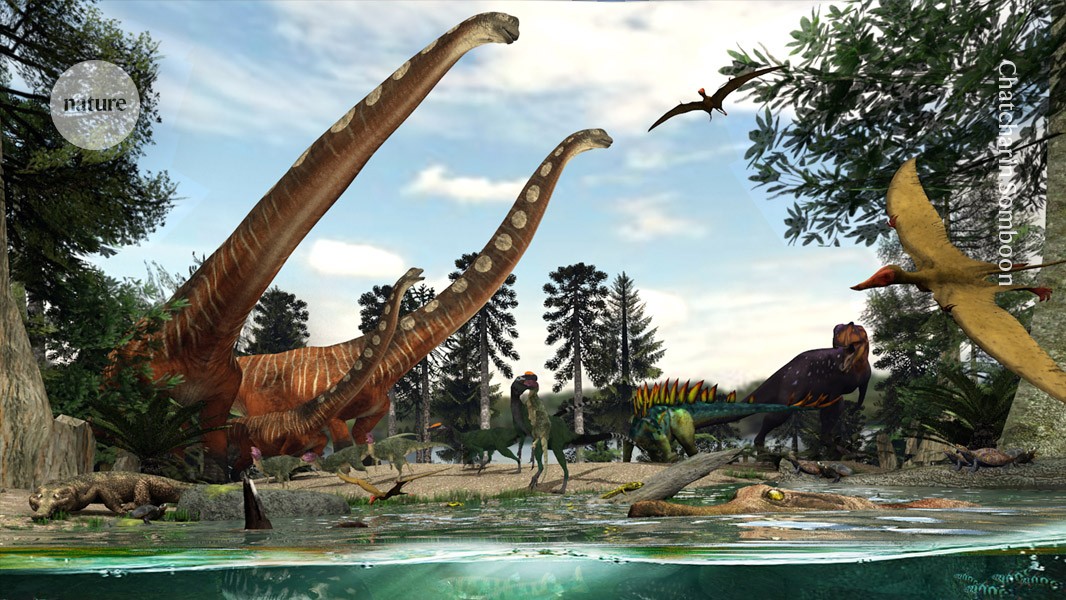Palaeontologists in Thailand have identified one of the first tyrannosauroid fossils in southeast Asia1. The discovery has excited researchers because so few specimens from the Late Jurassic epoch, around 150 million years ago, have been found in the region, in part owing to a lack of resources.
Palaeontological research in many southeast Asian countries is often led and funded by foreign institutions, say scientists from the region. They hope the latest finding, by a team of Thai palaeontologists, will encourage more local researchers to investigate the region’s dinosaur history.
“It’s a matter of finding one and the rest will follow,” says Daniel Lumbantobing, an evolutionary biologist with the Indonesian Society for Evolutionary Studies in Depok.
T. rex’s distant relative
The newly identified fossil belongs to the tyrannosauroid family, a group of bipedal predators that roamed Earth from the Middle Jurassic epoch to the late Cretaceous epoch, 174 million to 66 million years ago. The most famous member, Tyrannosaurus rex from North America, was the largest in size, measuring up to 12 metres in length and weighing 10,000 kilograms2. The new tyrannosauroid — identified using a set of teeth — was much smaller and nearly 100 million years older than T. rex, says study co-author Wongwech Chowchuvech, a palaeontologist at Kasetsart University, Bangkok. The discovery was published in the journal Tropical Natural History in June.
The teeth were excavated from the Late Jurassic layer of the Phu Kradung site in northern Thailand. The tyrannosauroid is probably “related to Guanlong wucaii tyrannosauroid in China”, says Chowchuvech, referring to the oldest species in the family.
Tyrannosauroid fossils have been found across the Northern Hemisphere, including in Russia, China and North America. The Thai tyrannosauroid suggests the group was widespread throughout the ancient supercontinent Laurasia, which consisted of what are now North America, Greenland, Europe and Asia, says Chowchuvech.
Chowchuvech found the dental specimens at the Sirindhorn Museum in Non Buri, Thailand, among many unidentified fossils from all over the country, including the Phu Kradung site. Chowchuvech knew that the site was dated to the Late Jurassic of Laurasia. He wondered whether some of the teeth in the museum were from tyrannosauroids. He examined three specimens that he suspected belonged to theropods, a larger group which includes tyrannosauroids. He then did a morphometric analysis— a method used to assess the size and shape of the dental specimens — and compared them with an existing data set of theropod dental characteristics. His analysis confirmed that all three samples were from a tyrannosauroid.
Palaontologist Xu Xing, from the Institute of Vertebrate Paleontology & Paleoanthropology in Beijing, said the study presented good evidence that the teeth belonged to a tyrannosauroid.
Fossil gaps
Scientists are curious about the lack of fossils from the Palaeozoic and Mesozoic eras, 541 million to 66 million years ago, from countries such as Thailand and Indonesia. Some wonder whether this absence has a scientific explanation, but Lumbantobing thinks it is related to the lack of resources for palaeontological research in the region.
Nussaïbah Raja, a palaeontologist at the University of Erlangen-Nuremberg in Erlangen, Germany, agrees. A lot of palaeontological research in low- and middle-income countries is led by “the interest of foreign researchers and institutions”, she says. And this has created a “sampling bias that distorts our understanding of past biodiversity”. She and her colleagues have found that high-income countries produced more than 97% of fossil data over the past 30 years3, creating an imbalance in global palaeontological research.
For instance, since Dutch palaeontologist Eugène Dubois unearthed a Homo erectus fossil in a riverbed in East Java, Indonesia, in 1891, palaeontological-research questions in the region have often focused on archaic humans, says Lumbantobing. Homo floresiensis was uncovered in eastern Indonesia4 and Homo luzonensis in the Philippines5, while the world’s oldest cave paintings have been found in Sulawesi, Indonesia. All these discoveries, which made headlines in international media, were connected to Australian institutions with more financial resources available than those in southeast Asia have.
Local teams
In the past five years, locally trained palaeontologists have started to investigate Thailand’s dinosaur history. Study co-author Sita Manitkoon, Chowchuvech’s supervisor at Mahasarakam University in Kham Riang, Thailand, has published about a dozen research papers on dinosaurs, inspiring Chowchuvech to formulate his own scientific questions. “In past decades, we did not have the knowledge and research techniques to conduct our own research properly,” Chowchuvech says. “We have gained invaluable knowledge and research techniques from many foreign palaeontologists, who have taught and supported us for decades, allowing us to run our own research in recent years.”
Raja and Chowchuvech think locally led research would help to diversify and decolonize palaeontology. “When local researchers drive the research, their priorities and interests are placed first, as it should be,” Raja says.


